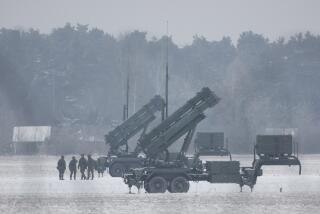Assessments Vary on Government’s Effectiveness : Philippine War: Neither Side Seen Having Advantage
- Share via
MANILA — Philippine Defense Secretary Fidel V. Ramos met with reporters Friday to answer one of the most-asked questions in Manila these days: Who is winning the long guerrilla war?
President Corazon Aquino, in her state of the nation address Monday, had answered the question in no uncertain terms. “This,” she said, “may be remembered as the year the insurgency was broken.”
But even as she spoke, opposition leader Juan Ponce Enrile, the former defense secretary, was offering a much different assessment. “The situation is grim,” he told a Manila Rotary Club gathering.
Graphic Evidence
Ramos, supported by an array of colored graphs and charts, made it clear that neither side is winning, at least not yet.
He said the armed forces are initiating more attacks than the guerrillas, and that an average of five guerrillas are being killed every day, compared to three soldiers or policemen.
“But of course we realize that body counts do not tell the whole story,” said Ramos, a West Point graduate and counterinsurgency expert.
Enrile, who was elected to the senate in 1987, had referred to a secret military document that proves, he said, that the government is actually losing the war.
The report, identified later as a top-secret quarterly assessment of the war by the operations branch of the Philippine Armed Forces, says among other things that the government forces won just one of the 14 major battles this year.
Enrile was sharply criticized by his congressional colleagues and by senior military officers for making the report public.
Defense Secretary Ramos said the report is genuine but that it deals with only one aspect of the war and neglects to cite more favorable reports for the same period prepared by military intelligence.
Ramos, a former army chief of staff, cited what he said were four major intelligence coups by the government in recent months, including the arrest of several top Communist Party leaders and the guerrilla movement’s chief military strategist, Romulo Kintanar, plus the seizure of dozens of computer discs containing detailed information on the Communists’ financial, communications and propaganda operations.
Communist Party leaders have confirmed that the arrests and seizures have dealt a serious blow to their effort to organize a popular uprising against the Aquino government.
Ramos mentioned one development he said is a serious concern: an attempt by the guerrillas to obtain surface-to-air missiles.
“This will add a new dimension to the struggle,” he said, “one that would be very disadvantageous to the armed forces. . . . If they succeed in obtaining the missiles, they can shoot down our helicopters and our transport aircraft, which are key elements in our operations. The armed forces are already spread very thin . . . and we need aircraft to move our forces from one place to another.”
Rebels Have the Cash
He said the guerrillas “appear to have the cash resources to buy these items, and these items are readily available in the international arms market.”
The Philippine government, he said, is using Philippine, U.S. and other “intelligence assets” around the world to prevent the guerrillas from acquiring missiles.
He said the government has developed a five-year counterinsurgency plan that will ultimately succeed in defeating the insurgent movement.
It is based, he said, on mobilizing civilians in the country’s 48,000 villages to secure areas liberated by the military. It calls for aggressive civilian development of schools, roads and water-supply systems in these areas.
The Aquino government has been sharply criticized for what some contend is the failure of her government to provide these kinds of services, and Ramos was pressed to say when the government will actually start delivering them.
“Let’s not be too impatient,” he replied. “We are right now building the government’s infrastructure that will lead to victory.”
As he spoke, military commanders in Quezon province southeast of Manila were giving in to a guerrilla demand that the region be cleared of government troops. This was one of the conditions for negotiations aimed at freeing five soldiers held by the guerrillas. The military has mounted a series of massive sweeps in an effort to find and free the hostages, who have been in guerrilla hands for two months.
More to Read
Sign up for Essential California
The most important California stories and recommendations in your inbox every morning.
You may occasionally receive promotional content from the Los Angeles Times.










